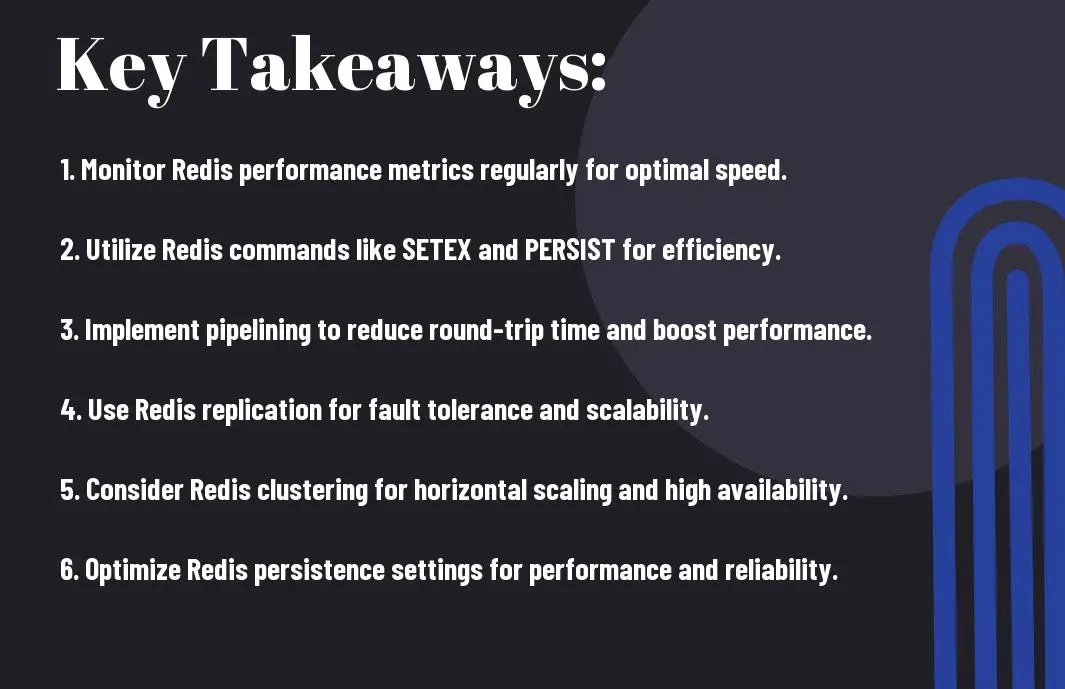Most websites can benefit greatly from utilizing the power of Redis Cache to enhance performance and speed up data access. Understanding how to optimize and tune Redis can make a significant difference in the responsiveness of your web application. In this blog post, we will explore into the important factors that impact Redis Cache performance, and provide valuable insights on how to maximize its potential to improve the speed and efficiency of your website.
Key Takeaways:
- Monitor Redis Cache Performance: Regularly track and analyze key performance metrics to identify any bottlenecks or issues affecting your web application.
- Optimize Redis Configuration: Fine-tune Redis settings and configurations to improve cache efficiency and responsiveness, ensuring faster data access and retrieval.
- Implement Caching Strategies: Utilize caching strategies like data partitioning, expiration policies, and data serialization to maximize Redis Cache performance and enhance overall web site speed.

Understanding Redis Cache
What is Redis Cache?
To understand Redis Cache, we need to first grasp the concept of caching. Caching is the process of storing frequently accessed data in a temporary storage area to speed up the retrieval process. Redis Cache, in this regard, is an open-source, in-memory data structure store that can be used as a database, cache, and message broker. It supports various data structures such as strings, hashes, lists, sets, and more, making it a versatile choice for caching needs.
Benefits of using Redis Cache
Redis Cache offers numerous benefits for optimizing web performance and data access. Some of the key benefits include fast access times due to its in-memory data storage, highly scalable architecture that can handle large amounts of data, support for data persistence to prevent data loss, and built-in replication for high availability and fault tolerance.
For instance, Redis can significantly reduce the response times of web applications by caching frequently accessed data in memory, thereby decreasing the load on the primary database and improving overall system performance. Its support for data partitioning also allows for distributed caching, enabling efficient storage and retrieval of data across multiple nodes.
How Redis Cache Works
Storing data in Redis Cache
Redis Cache is an in-memory data store that can be used to store and retrieve data quickly. It works by keeping frequently accessed data in memory, which reduces the need to fetch it from the database every time a user requests it. When data is stored in Redis Cache, it is assigned a key that can be used to quickly retrieve the data later on.
Retrieving data from Redis Cache
Redis allows you to retrieve data quickly by providing the key used to store the data in the cache. It checks if the data with that key exists in memory, and if it does, the data is retrieved almost instantly. This can greatly improve the performance of your web application and reduce load times for users.
Cache retrieval in Redis is incredibly fast, but it’s important to consider the expiration time for your cached data. Setting appropriate expiration times ensures that you are not serving outdated content to users.

Factors Affecting Redis Cache Performance
Now, let’s probe the factors that can significantly impact the performance of your Redis Cache. Understanding and optimizing these factors can help accelerate your web site and data access while leveraging the benefits of Redis caching.
Server Configuration and Resource Allocation
For optimal Redis Cache performance, it is critical to ensure that your server configuration and resource allocation are appropriately set up. The memory allocation for Redis should be carefully configured to accommodate the data size and traffic volume. Additionally, the number of connections, CPU resources, and disk I/O should be optimized for efficient caching operations.
The Redis Cache performance can be severely impacted if the server configuration is not well-tuned. Ensure that you regularly monitor and adjust the server settings to maintain high performance levels.
Data Size and Complexity
Factors such as data size and complexity play a crucial role in the performance of your Redis Cache. Large data sets or complex data structures can increase the latency of cache operations and impact the overall responsiveness of your web applications.
Allocation of memory and resources becomes critical when dealing with large or intricate data sets. It is important to optimize the data structures and design efficient caching strategies to ensure optimal performance.
Optimizing Redis Cache for Better Performance
Caching Frequently Accessed Data
Many websites and applications can benefit greatly from caching frequently accessed data in Redis. By storing this data in memory, Redis can quickly retrieve it without having to query the database each time. This results in faster response times and improved overall performance. Caching frequently accessed data such as user sessions, configuration settings, or frequently displayed content can significantly reduce the load on your database and speed up your web site.
Implementing Efficient Data Retrieval
On top of caching frequently accessed data, efficient data retrieval is crucial for maximizing performance with Redis. Use Redis commands such as pipelining, multi/exec transactions, and Lua scripting to optimize the way data is retrieved from the cache. By minimizing round trips to the Redis server and leveraging these advanced features, you can further enhance the speed and efficiency of your data access.
Efficient data retrieval not only improves performance but also helps in reducing the network overhead and latency associated with retrieving data from Redis. By carefully designing your data access patterns and utilizing Redis features wisely, you can unlock the full potential of Redis caching for your web site or application.
Common Issues with Redis Cache
Cache Misses and Cache Invalidations
After setting up Redis Cache, one common issue that users face is dealing with cache misses and cache invalidations. A cache miss occurs when Redis does not have the requested data stored in the cache, leading to a direct query to the backend server. This can impact the performance of your web application, as it defeats the purpose of using a cache for quick data retrieval. Additionally, cache invalidations become crucial when the cached data becomes outdated and needs to be removed or updated to maintain data integrity.
Handling Errors and Exceptions
Common errors and exceptions can occur when working with Redis Cache, such as network connection issues, incorrect configuration settings, or exceeding memory limits. It is vital to have proper error handling mechanisms in place to gracefully manage these situations and prevent potential data loss or application crashes.
Plus, it’s imperative to monitor and log errors and exceptions to quickly identify and resolve them, ensuring the smooth functioning of your Redis Cache and web application.
To wrap up
Unraveling the Redis Cache performance is a critical step towards speeding up your website and enhancing data access. By carefully monitoring and fine-tuning the configuration settings, optimizing key design choices, and leveraging advanced features such as pipelining and clustering, you can significantly boost your application’s responsiveness and scalability. Remember to regularly assess your system’s performance metrics, track any anomalies, and adjust your caching strategies accordingly to ensure peak efficiency.
With the insights gained from this process, you will be better equipped to harness the full power of Redis Cache and deliver an exceptional user experience through fast-loading pages, reduced database workload, and improved overall performance. By prioritizing performance optimization and implementing best practices, you can stay ahead of the curve in the competitive digital landscape and drive success for your web applications and data-driven projects.
FAQ
Q: What is Redis Cache and how does it improve web site performance?
A: Redis Cache is an open-source, in-memory data structure store that can be used as a database, cache, and message broker. It helps to speed up web site performance by storing frequently accessed data in memory, allowing for faster retrieval times compared to traditional disk-based databases.
Q: How can I optimize Redis Cache performance for my web site?
A: To optimize Redis Cache performance, you can employ strategies such as using data partitioning, enabling Redis persistence to prevent data loss, configuring appropriate eviction policies to manage memory usage, and utilizing Redis clustering for high availability and scalability.
Q: What are some best practices for utilizing Redis Cache for data access?
A: Some best practices for utilizing Redis Cache for data access include minimizing round trips to the Redis server by fetching multiple keys in a single operation, using pipelining to reduce network latency, performing proper data serialization/deserialization, and monitoring Redis performance metrics to identify bottlenecks and optimize configurations.




